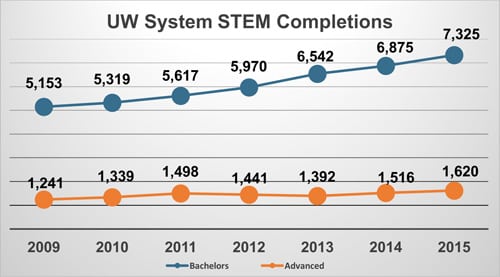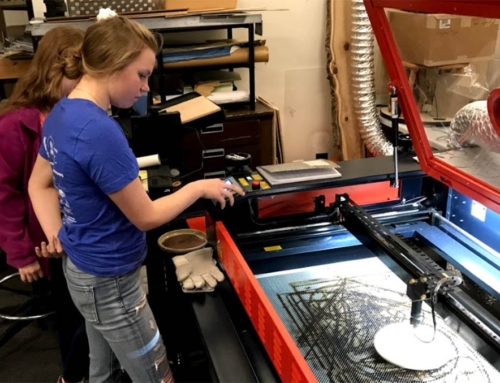Wisconsin sees rise in degrees in STEM fields

It’s encouraging news, then, that the number of graduates from Wisconsin technical colleges’ and universities’ STEM programs has been rising in recent years, both at the bachelor’s and at the advanced degree level.
“Wisconsin’s STEM talent pipeline is crucial to its success in the global economy,” says Lee Swindall, vice president for sector strategy development for the Wisconsin Economic Development Corporation (WEDC). “This trend means our companies will have an easier time finding the skilled labor they need, and the existence of a skilled and highly educated labor pool will draw new companies to our state. WEDC will continue to work with its partners to keep the numbers of graduates in these fields growing.”
According to data from the National Center for Education Statistics’ IPEDS database, the number of graduates in STEM fields has been steadily growing since 2009. A total of 7,325 undergraduate and 1,620 graduate degrees in STEM-related fields were conferred by the University of Wisconsin System (UW System) in 2015, compared to 5,153 undergraduate and 1,241 graduate degrees in 2009. These increases took place not just in Madison and Milwaukee, but at University of Wisconsin campuses across the state.
For the purposes of WEDC’s analysis, a number of STEM-related fields were included, in addition to engineering degrees: natural resources and conservation, communications technologies/technicians and support services, computer and information sciences and support services, biological and biomedical sciences, mathematics and statistics, physical sciences, agriculture, architecture and science technologies/technicians.
Swindall attributes the growth in degree completions in these fields to a combination of factors. Not only did people choose to enroll in degree programs to gain new skills and training during the recession, but the field also drew people away from banking, another quantitative field whose reputation and strength took a hit during the economic downturn.
In Wisconsin from 2010 to 2015, the number of graduates from these programs increased at a rate higher than the national average, reflecting the quality of Wisconsin’s STEM education and the increased focus its institutions have been placing on recruiting.
Swindall notes that the majority of the growth can be attributed to the University of Wisconsin System, where the number of bachelor’s degrees in STEM fields grew by 38 percent from 2010 to 2015, compared to a national average of 29 percent.
“The UW System is one of the best statewide public university systems in the country, and it has had high-quality programs in engineering-related fields for a long time,” says Swindall. “Now, the system’s focus on raising the profile of its programs, and on connecting with talented students, is paying off in the form of more applicants and more degrees granted.”
To zoom in on a single year at UW-Madison alone, in 2015 educational completions in stem fields accounted for over one-third of the university’s total degrees granted, whereas nationally, STEM degrees only account for 15 percent of all degrees granted.
The growth rate for Wisconsin’s pool of graduates was especially high in one field—computer and information sciences and support services—where the number of undergraduate degrees granted by the UW System increased by 61 percent from 2010 to 2015, compared to a national average of 41 percent during the same timeframe.
But if Wisconsin is truly going to reap the benefits of these highly skilled graduates, it must also pay attention to keeping them here, says Swindall—job seekers who hold these degrees are in demand not just in Wisconsin but across the country and around the world.
Due to the high quality of Wisconsin’s engineering programs, these graduates are in demand, and at some schools as many as 80 percent of graduates take jobs out of state. WEDC’s new Think-Make-Happen marketing strategy, a collaborative marketing effort with partners including young professionals’ groups, aims to increase Wisconsin students’ awareness of opportunities within the state.
The goal, says WEDC Deputy Secretary and Chief Operating Officer Tricia Braun, is to retain the best and brightest talent in Wisconsin by making sure engineering jobs are available here, and by making sure the state has a quality of life that appeals to these highly educated graduates—factors that ultimately reinforce one another in a sort of snowball effect.
“Wisconsin is a dynamic environment for business, where creative and innovative ideas lead to new products and technologies that solve society’s problems—and it’s a fun place to live, with a multitude of recreational opportunities and an outstanding quality of life,” says Braun. “Wisconsin natives and newcomers alike speak highly of their experience and love this state, but we have learned that we can do a better job promoting Wisconsin to the non-resident talent at our universities, as well as outside the state.”
“Above all, we are elated that the numbers of engineering graduates are rising so rapidly,” says Braun. “With the right conditions to persuade these graduates to stay here, Wisconsin will fortify its status as a hub for engineering and technology.”









FOLLOW US